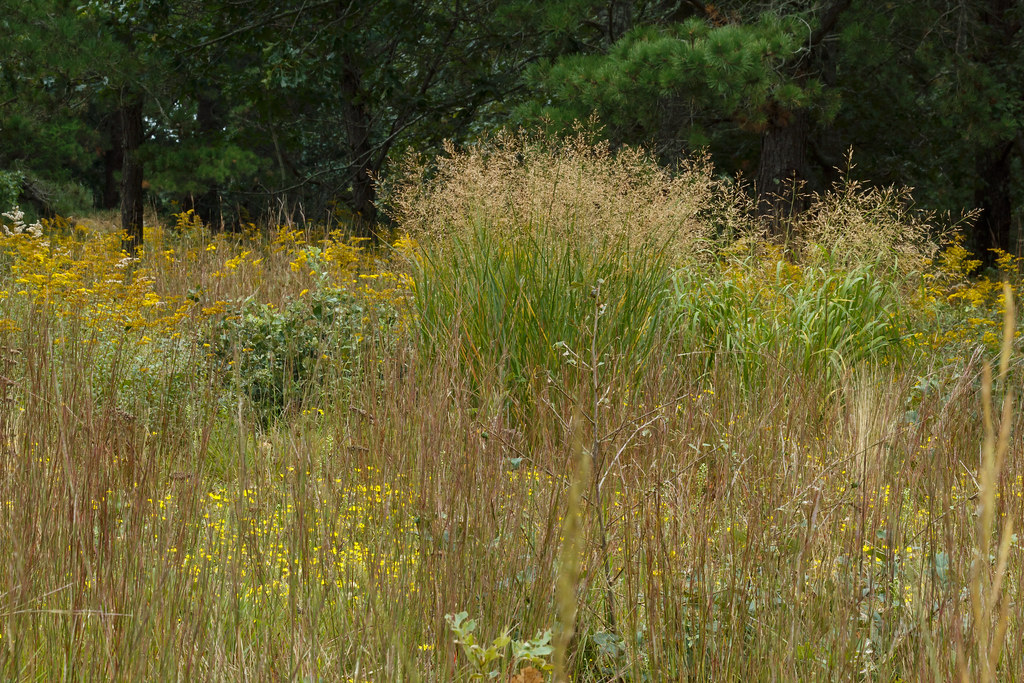Warm Season Grasses for Wildlife
Warm season grasses are grasses that grow best during the summer (June-August) and often form large clumps. These grasses provide excellent wildlife habitat, in addition to erosion control. Warm season grasses typically are tall plants with large root systems that help keep soil in place.
Many warm season grasses are colorful and have large seed heads which can provide food for some wildlife species. The main wildlife benefit of native warm season grasses is the cover that they provide. Maryland has several native species of warm season grasses, which are listed in the table below.
| Name | Height | Soil/Light Requirements |
|
Big bluestem (Andropogon gerardii) |
5-7 ft | Tolerates dry sites with acidic, sandy, loamy, or clayey soils; requires full sun |
| Broomsedge bluestem (Andropogon virginicus) | 2-4 ft | Tolerates a wide variety of soils, including old fields with low fertility. |
|
Eastern gamagrass (Tripsacum dactyloides) |
6-8 ft | Tolerates moist, well-drained soils; prefers fertile sites; requires full to partial sun |
|
Little bluestem (Schizachyrium scoparium) |
2-4 ft | Tolerates dry sites with acidic, sandy, loamy or clayey soils; requires full sun |
|
Indiangrass (Sorghastrum nutans) |
4-6 ft | Tolerates dry-moderately wet sites; requires full sun |
|
Switchgrass (Panicum virgatum) |
4-6 ft | Tolerates dry-wet sites with acidic, sandy, loamy, or clayey soils; requires full to partial sun |
The bunching growth habit of most warm season grasses allows for open space at ground level. This space allows smaller species, like northern bobwhite quail,to safely navigate through the grasses. If growing a warm season grass meadow for wildlife, it is recommended that the meadow contains about 50% native warm season grasses and 50% forbs and shrubs. This mixed habitat will help support food and cover requirements for a variety of wildlife species. To keep the desired open space at ground level, periodic disking and mowing may be necessary. For more information about creating and maintaining warm season grass meadows, click on the following resource links below:
- Native Warm Season Grasses guide by the University of Tennessee
- Native Warm Season Grass (NWSG) by The Virginia Department of Wildlife Resources Renovating Native Warm-Season Grass Stands for Wildlife by Purdue Extension
For backyard gardeners, these native warm season grasses can provide additional benefits and aesthetics in gardens. Tall, clumping grasses, like switchgrass, are an excellent alternative to the invasive Chinese silvergrass (Miscanthus sinensis). Shorter grasses, like little bluestem, can also provide winter interest to gardens, as well as serve as a host plant for multiple species of skipper butterflies in Maryland. Numerous songbirds and small mammals eat the seeds of indiangrass. Consider adding a few clumps of warm season grasses to your backyards to help local wildlife!

Warm season grasses can bring fun textures and winter appeal to backyard gardens, by Rachel James CC by SA NC 2.0
For More Information:
- Mowing and Upland Wildlife (Maryland)
- Warm Season Grasses and Wildlife (Maryland)
Happy Fall!
Spending more time at home means I’m spending more time in the backyard. I have been in awe at the sights I have missed over the years. Lately, I have been watching the backyard monarchs as if they were my own children! As the days get shorter, here are a few things to consider this time of year:
I’m also excited to announce the new Wild Acres public events page which will feature upcoming webinars sponsored by the Wildlife and Heritage Service. In addition, the Gardening for Pollinators webinar is now available on-demand. HabiChat subscribers will receive webinar updates as they are scheduled.
Furthermore, if you are in need of trees and shrubs for conservation or lumber, check out the Maryland State Tree Nursery which will soon be accepting orders for Spring 2021.
In this issue, you can learn about the lovely black and yellow garden spiders which can be seen this time of year, as well as information on the vigorous, native switchgrass. Additional articles include information on the importance of warm season grasses and why leaving flower stems up through the winter helps pollinators.
Happy Habitats,
Kerry Wixted
Click here to have HabiChat—the quarterly backyard wildlife habitat newsletter from the Wild Acres program—delivered right to your inbox!
In this Issue
Native Plant Profile: Switchgrass
Native Animal Profile: Black and Yellow Garden Spider
Creating Habitat for Stem-Nesting Bees



 1-888-373-7888
1-888-373-7888 233733
233733